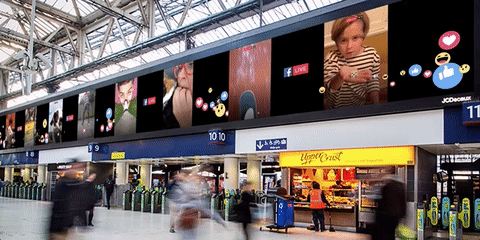

While most people still aren’t sure what to broadcast, and some have misused the format for unsavory or criminal purposes, Facebook says one-fifth of the videos shared on its network are now Live videos. It’s also seen the Live broadcasting daily watch time grow 4X in the past year, according to Facebook’s head of video, Fidji Simo.
This shows Facebook’s efforts to own the verb “Live” are paying off.
Live streaming didn’t blow up like it seemed it would in 2015, when Meerkat rekindled the market, Twitter dove in with Periscope and Facebook began testing Live. Now, after middling usage, $100 million in payments to broadcasters, a massive physical advertising campaign and problems with live-streamed violence, some are questioning Mark Zuckerberg’s decision to put the company on lockdown to rapidly launch the feature.
But it wasn’t worth the risk for Facebook to wait and see. If live streaming became popular, Facebook needed to own the verb “Live” — to be the first tool people thought of when they saw something worth broadcasting.
Social apps live and die by network effect. The first one to do a feature the right way can roll up a snowball of user traction.
Facebook sat back and watched Snapchat turn into a juggernaut with its Stories feature. Failing to acquire it with what would look like a low-ball offer, Facebook is now late to the Stories game and desperately trying to play catch up.
After the press pounced on Meerkat in February 2015, Twitter launched its acquisition, Periscope. Facebook saw the potential nightmare of the world “Periscoping” weddings, parties, sporting events and breaking-news moments. After largely vanquishing Twitter in terms of scale, it didn’t want it making a comeback on mobile video. Nor did Facebook want Snapchat to swoop in with a “cool” take on live streaming.
So after some rapid development, Facebook launched the first tests of Live with celebrities in August 2015, and expanded it to all U.S. iPhone users in January. Soon, it had discovered a critical stat, according to The Wall Street Journal: 75 percent of users were high school or college kids. Live was a chance to attract the youth demographic and original-content sharing Facebook was losing to Snapchat.
Mark Zuckerberg decided to reallocate resources to Live and put more than 100 employees on “lockdown” building it for all Facebook users. It would go on to buy an international blitz of billboards, bus stops and commercials to teach people how and when to go Live — an attempt to cement its grip on the verb.
The company knew there might be objectionable-content troubles, but underestimated their scope. There have been dozens of instances of violence and suicides on Live that should have been censored. Meanwhile, Facebook has mistakenly censored some graphic but newsworthy videos, like the aftermath of the police shooting of Philando Castile.
But if Facebook can entrench itself as the place for Live broadcasts, it seems to believe it can solve the rest of the content quality and safety issues over time. Move fast and break things is still Facebook’s philosophy, even if it’s tried to distance itself from the phrase.

